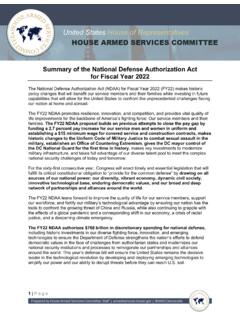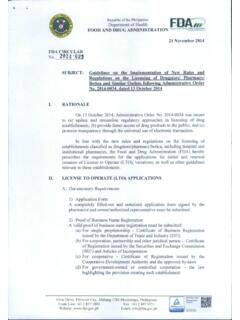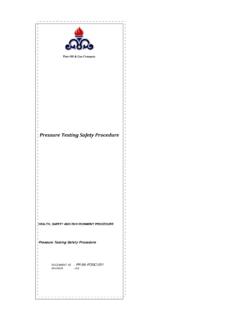Transcription of Recommendation for Key Management - NIST
1 NIST Special Publication 800-57 Part 3. Revision 1. Recommendation for Key Management Part 3: Application-Specific Key Management Guidance Elaine Barker Quynh Dang This publication is available free of charge from: C O M P U T E R S E C U R I T Y. NIST Special Publication 800-57 Part 3. Revision 1. Recommendation for Key Management Part 3: Application-Specific Key Management Guidance Elaine Barker Quynh Dang Computer Security Division Information Technology Laboratory This publication is available free of charge from: January 2015. Department of Commerce Penny Pritzker, Secretary National Institute of Standards and Technology Willie May, Acting Under Secretary of Commerce for Standards and Technology and Acting Director Authority This publication has been developed by NIST to further its statutory responsibilities under the Federal Information Security Management Act (FISMA), Public Law ( ) 107-347. NIST is responsible for developing information security standards and guidelines, including minimum requirements for Federal information systems, but such standards and guidelines shall not apply to national security systems without the express approval of appropriate Federal officials exercising policy authority over such systems.
2 This guideline is consistent with the requirements of the Office of Management and Budget (OMB) Circular A-130, Section 8b(3), Securing Agency Information Systems, as analyzed in Circular A-130, Appendix IV: Analysis of Key Sections. Supplemental information is provided in Circular A-130, Appendix III, Security of Federal Automated Information Resources. Nothing in this publication should be taken to contradict the standards and guidelines made mandatory and binding on Federal agencies by the Secretary of Commerce under statutory authority. Nor should these guidelines be interpreted as altering or superseding the existing authorities of the Secretary of Commerce, Director of the OMB, or any other Federal official. This publication may be used by nongovernmental organizations on a voluntary basis and is not subject to copyright in the United States. Attribution would, however, be appreciated by NIST. National Institute of Standards and Technology Special Publication 800-57 Part 3, Revision 1.
3 Natl. Inst. Stand. Technol. Spec. Publ. 800-57 Part 3, Revision 1, 102 pages (January 2015). CODEN: NSPUE2. This publication is available free of charge from: Certain commercial entities, equipment, or materials may be identified in this document in order to describe an experimental procedure or concept adequately. Such identification is not intended to imply Recommendation or endorsement by NIST, nor is it intended to imply that the entities, materials, or equipment are necessarily the best available for the purpose. There may be references in this publication to other publications currently under development by NIST. in accordance with its assigned statutory responsibilities. The information in this publication, including concepts and methodologies, may be used by Federal agencies even before the completion of such companion publications. Thus, until each publication is completed, current requirements, guidelines, and procedures, where they exist, remain operative.
4 For planning and transition purposes, Federal agencies may wish to closely follow the development of these new publications by NIST. Organizations are encouraged to review all draft publications during public comment periods and provide feedback to NIST. All NIST Computer Security Division publications, other than the ones noted above, are available at National Institute of Standards and Technology Attn: Computer Security Division, Information Technology Laboratory 100 Bureau Drive (Mail Stop 8930) Gaithersburg, MD 20899-8930. Email: ii Reports on Computer Systems Technology The Information Technology Laboratory (ITL) at the National Institute of Standards and Technology (NIST) promotes the economy and public welfare by providing technical leadership for the Nation's measurement and standards infrastructure. ITL. develops tests, test methods, reference data, proof of concept implementations, and technical analyses to advance the development and productive use of information technology.
5 ITL's responsibilities include the development of Management , administrative, technical, and physical standards and guidelines for the cost-effective security and privacy of other than national security-related information in Federal information systems. The Special Publication 800-series reports on ITL's research, guidelines, and outreach efforts in information system security, and its collaborative activities with industry , government, and academic organizations. Abstract NIST Special Publication 800-57 provides cryptographic key Management guidance. It consists of three parts. Part 1 provides general guidance and best practices for the Management of cryptographic keying material. Part 2 provides guidance on policy and security planning requirements for government agencies. Finally, Part 3 provides guidance when using the cryptographic features of current systems. Keywords accreditation; assurances; authentication; authorization; availability; backup.
6 Certification; compromise; confidentiality; cryptanalysis; cryptographic key;. cryptographic module; digital signature; key Management ; key Management policy; key recovery; private key; public key; public key infrastructure; security plan; trust anchor;. validation. iii Acknowledgements The co-authors of this version of SP 800-57, Part 3 greatly appreciate the contributions of previous co-authors of this document, namely William Burr, Alicia Jones, Timothy Polk, Scott Rose and Miles Smid. We also appreciate contributions by Katrin Reitsma, Sheila Frankel, David Cooper, Judith Spencer, the National Security Agency (NSA) and many others in the public and private sectors whose thoughtful and constructive comments improved the quality and usefulness of this publication. iv Table of Contents 1 Introduction .. 1. Purpose ..2. Requirement Terms ..3. General Protocol Considerations ..3. Mandatory-to-Implement versus Optional-to-Implement ..4. Cryptographic Negotiation.
7 4. Single or Multi-Use Keys ..6. Algorithm and Key Size Transition ..6. 2 Public Key Infrastructure (PKI) .. 8. Description ..8. Security and Compliance Recommended Key Sizes and Algorithms ..11. Procurement Guidance ..14. CA/RA Software and Hardware: ..14. OCSP Responders: ..15. Cryptographic Modules ..16. Key Recovery Servers ..16. Relying Party Client Software ..17. Recommendations for System Installers/Administrators ..17. Certificate Issuance ..17. Certificate Revocation Certificate Revocation List Generation ..19. PKI Repositories for the Distribution of Certificates and CRLs ..19. OCSP Responders ..20. Backup and Archive ..20. Relying Party Integration and Configuration ..20. User Guidance (Subscribers)..21. 3 Internet Protocol Security (IPsec) .. 23. Description ..23. Security and Compliance Cryptographic Algorithms ..25. Additional Recommendations ..29. Procurement Guidance ..29. Recommendations for System Installers ..30. Recommendations for System Administrators.
8 30. Recommendations for End Users ..30. 4 Transport Layer Security (TLS) .. 30. 5 Secure/Multipart Internet Mail Extensions (S/MIME) .. 31. Description ..31. Security and Compliance Procurement Guidance ..34. v Recommendations for System Installers ..34. Recommendations for System Administrators ..35. Recommendations for End Users ..35. 6 36. Description ..36. Security and Compliance Procurement Guidance ..40. Recommendations for System Installers ..40. Recommendations for System Administrators ..41. Recommendations for End Users ..42. 7 Over-The-Air Rekeying (OTAR) Key Management Messages (KMMs) .. 43. Description ..43. Security and Compliance Cryptographic Algorithms ..44. Message Authentication and Cryptoperiods ..44. Key Usage ..44. Backup ..45. Rekeying ..45. Random bit generators ..45. Procurement Guidance ..45. Recommendations for System Installers ..46. Recommendations for System Administrators ..46. Recommendations for End Users ..47. 8 Domain Name System Security Extensions (DNSSEC).
9 48. Description ..48. DNS Data Authentication ..49. DNS Transaction Authentication ..49. DNS Cryptographic Algorithms/Schemes, Modes and Combinations ..50. Special Considerations for Key Special Considerations for NSEC3 ..52. Security/Compliance Issues ..52. Procurement Guidance ..53. Recommendations for System Installers ..53. Recommendations for System Installers (Authoritative Servers) ..53. Recommendations for System Installers (Caching Recursive Servers) ..54. Recommendations for System Installers (Client Systems) ..54. Recommendations for System Administrators ..54. Recommendations for System Administrators (Authoritative Server) ..54. Recommendations for System Administrators (Caching Recursive Servers) ..54. Recommendations for System Administrators (Client Systems) ..55. Recommendations for End Users ..55. 9 Encrypted File Systems (EFS).. 56. Description ..56. Number of Keys Required ..56. vi Access to Symmetric Keys used in File Encryption.
10 58. Security and Compliance Recommendations for Procurement Officials ..60. Recommendations for System Installers ..61. Recommendations for System Administrators ..61. Recommendations for End Users ..61. 10 The Secure Shell (SSH) .. 62. Description ..62. Transport Layer Protocol (SSH-TLP) ..62. The User Authentication Protocol (UAP) ..62. Connection Protocol (CP) ..63. Security and Compliance Issues ..63. TLP Issues ..63. UAP Issues ..67. Procurement Guidance ..68. Recommendations for System Installers ..68. Recommendations for System Administrators ..69. Recommendations for End Users ..69. Appendix A: Glossary .. 70. Appendix B: Acronyms .. 77. Appendix C: A Word to Novice End Users .. 79. Appendix D: References .. 81. Appendix E: Revision Changes .. 93. vii Recommendation FOR KEY Management . Part 3: Application-Specific Key Management Guidance 1 Introduction Application-Specific Key Management Guidance, Part 3 of the Recommendation for Key Management is intended primarily to help system administrators and system installers adequately secure applications based on product availability and organizational needs and to support organizational decisions about future procurements.















